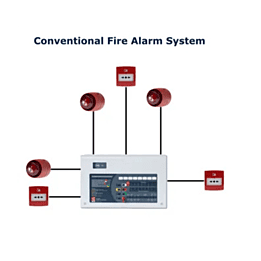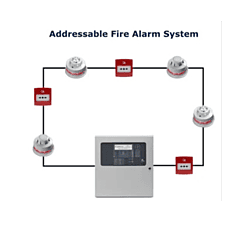Fire Alarm Systems
A fire alarm system is a safety system designed to detect smoke, heat, or fire, and alert occupants through audible and visual signals (such as sirens, bells, or flashing lights), enabling a safe and timely evacuation.
These systems typically include:
Smoke detectors
Heat detectors
Manual call points (pull stations)
Alarm sounders and flashers
Control panels
Fire alarm systems are critical in homes, offices, factories, and public buildings to prevent loss of life and property during fire emergencies.
Type of Fire Alarm Systems

Conventional Fire Alarm System
- Wiring: Divides the building into zones; each zone has a circuit.
- Identification: Only indicates the zone where the alarm is triggered, not the exact device.zone where the alarm is triggered, not the exact device.zone where the alarm is triggered, not the exact device.zone where the alarm is triggered, not the exact device.zone where the alarm is triggered, not the exact device.zone where the alarm is triggered, not the exact device.
- Cost: More economical for smaller buildings.smaller buildings.smaller buildings.smaller buildings.smaller buildings.smaller buildings.
- Example Use: Small offices, shops, schools.

Addressable Fire Alarm System
- Wiring: All devices are connected in a loop.
- Identification: Every device (smoke detector, call point, etc.) has a unique address, allowing pinpoint detection.unique address, allowing pinpoint detection.unique address, allowing pinpoint detection.unique address, allowing pinpoint detection.unique address, allowing pinpoint detection.
Cost: More expensive but ideal forlarger or complex buildings.....
- Example Use: Hospitals, malls, high-rise buildings.




